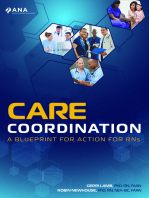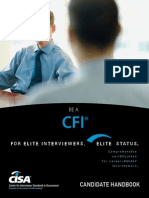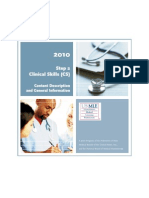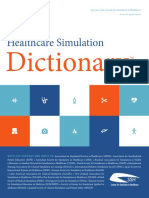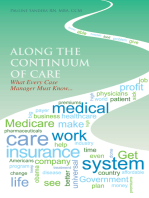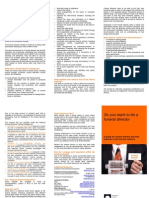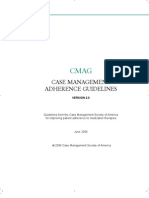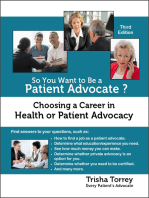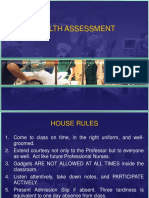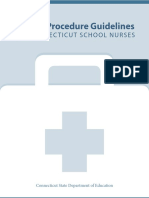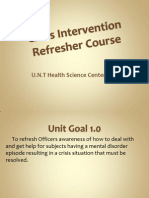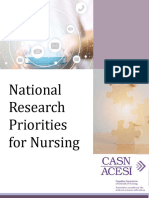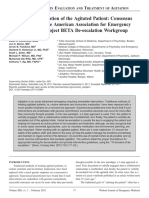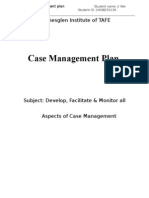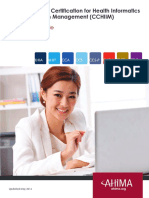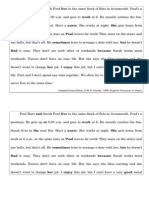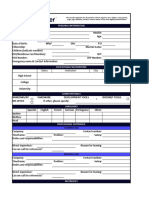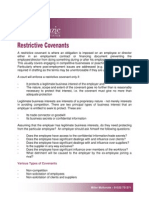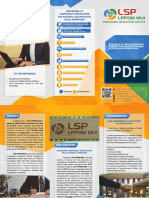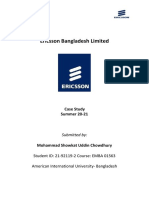Case Management Handbook
Uploaded by
Sylvia ChristmasCase Management Handbook
Uploaded by
Sylvia ChristmasAmerican Board for
Occupational Health Nurses, Inc.
CANDIDATE HANDBOOK
Case Management Examination
201 East Ogden, Suite 114 Hinsdale, Illinois 60521-3652 630-789-5799 Fax 630-789-8901 www.abohn.org
American Board for
Occupational Health Nurses, Inc.
Case Management Examination CANDIDATE HANDBOOK
TABLE
OF
CONTENTS
HOW TO PREPARE FOR THE EXAMINATION . . . . . . . . . . 10 Passing Candidates Examination Preparation . . . . . . . . . . 10 Your Examination Preparation Plan . . . . . . . . . . . . . . . . . . 11 ON THE DAY OF YOUR EXAMINATION . . . . . . . . . . . . . . 11 Security . . . . . . . . . . . . . . . . . . . . . . . . . . . . . . . . . . . . . . 11 Practice Examination . . . . . . . . . . . . . . . . . . . . . . . . . . . . 12 Timed Examination. . . . . . . . . . . . . . . . . . . . . . . . . . . . . . 12 Inclement Weather or Emergency. . . . . . . . . . . . . . . . . . . 12 Rules for Examination . . . . . . . . . . . . . . . . . . . . . . . . . . . . 12 REFERENCES . . . . . . . . . . . . . . . . . . . . . . . . . . . . . . . . . . . . 13 TAKING THE EXAMINATION. . . . . . . . . . . . . . . . . . . . . . . 15 Experimental Questions and Guessing . . . . . . . . . . . . . . . 15 Sample Examination Questions. . . . . . . . . . . . . . . . . . . . . 15 FOLLOWING THE EXAMINATION . . . . . . . . . . . . . . . . . . 16 If You Pass the Examination . . . . . . . . . . . . . . . . . . . . . . . 17 If You Do Not Pass the Examination . . . . . . . . . . . . . . . . . 17 Confidentiality . . . . . . . . . . . . . . . . . . . . . . . . . . . . . . . . . 17 Duplicate Score Report. . . . . . . . . . . . . . . . . . . . . . . . . . . 17 Scores Canceled by ABOHN or AMP. . . . . . . . . . . . . . . . 17 REVOCATION OF CERTIFICATION . . . . . . . . . . . . . . . . . . 17 Appeals Process . . . . . . . . . . . . . . . . . . . . . . . . . . . . . . . . 18 RETAINING CERTIFICATION . . . . . . . . . . . . . . . . . . . . . . . 18 ABOHN COHN EXAMINATION APPLICATION. . . . . . . . . 19 REQUEST FOR SPECIAL EXAMINATION ACCOMMODATIONS FORM . . . . . . . . . . . . . . . . . . . . . . . 23 DOCUMENTATION OF DISABILITY-RELATED NEEDS. . . . 24
OCCUPATIONAL HEALTH NURSING CASE MANAGEMENT . . . . . . . . . . . . . . . . . . . . . . . . . . . . . . . . . . 1 ABOUT ABOHN . . . . . . . . . . . . . . . . . . . . . . . . . . . . . . . . . 1 STATEMENT OF NONDISCRIMINATION . . . . . . . . . . . . . . 2 ABOUT THIS HANDBOOK . . . . . . . . . . . . . . . . . . . . . . . . 2 ABOUT ABOHNS TESTING AGENCY, AMP . . . . . . . . . . . 2 THE CERTIFICATION EXAMINATION . . . . . . . . . . . . . . . . 2 Examination Construction. . . . . . . . . . . . . . . . . . . . . . . . . . 2 EXAMINATION FORMAT AND CONTENT . . . . . . . . . . . . 2 Examination Content . . . . . . . . . . . . . . . . . . . . . . . . . . . . 2 EXAMINATION ELIGIBILITY REQUIREMENTS. . . . . . . . . . 5 Examination Application. . . . . . . . . . . . . . . . . . . . . . . . . . 5 APPLICATION COMPLETION GUIDELINES . . . . . . . . . . . Document Copies . . . . . . . . . . . . . . . . . . . . . . . . . . . . . . General Instructions . . . . . . . . . . . . . . . . . . . . . . . . . . . . . Guide to Code Numbers . . . . . . . . . . . . . . . . . . . . . . . . . Continuing Education . . . . . . . . . . . . . . . . . . . . . . . . . . . . Alternatives to Continuing Education . . . . . . . . . . . . . . . . Application Checklist . . . . . . . . . . . . . . . . . . . . . . . . . . . . 5 5 6 6 7 8 8
SCHEDULING AN EXAMINATION APPOINTMENT . . . . . 9 Examination Appointment Changes/Failure to Report or to Schedule an Examination . . . . . . . . . . . . . . . . . . . . . 9 Examination Accommodations . . . . . . . . . . . . . . . . . . . . . 10 Telecommunication for the Deaf. . . . . . . . . . . . . . . . . . . . 10 FEES . . . . . . . . . . . . . . . . . . . . . . . . . . . . . . . . . . . . . . . . . . 10 Fee Payments . . . . . . . . . . . . . . . . . . . . . . . . . . . . . . . . . . 10 Application Fee . . . . . . . . . . . . . . . . . . . . . . . . . . . . . . . . 10 Examination Fee . . . . . . . . . . . . . . . . . . . . . . . . . . . . . . . . 10 Examination Authorization Extension Fee . . . . . . . . . . . . . 10 Declined Credit Cards, Returned Checks, and Handling Fees . . . . . . . . . . . . . . . . . . . . . . . . . . . . . . . . . 10 No Refunds . . . . . . . . . . . . . . . . . . . . . . . . . . . . . . . . . . . 10
Copyright 2009 by the American Board for Occupational Health Nurses, Inc. All rights reserved. Any duplication or reproduction of all or any portion of these materials without the express written permission of the American Board for Occupational Health Nurses, Inc. is prohibited.
Printed date: 5/09
American Board for
Occupational Health Nurses, Inc.
Case Management Examination CANDIDATE HANDBOOK 1
Specialist (COHN-S). The mastery of occupational health nursing, as evidenced by the core credential, complements and enhances the effectiveness of occupational health nursing case management. Therefore, the roles validated by the core credentials understandably form the basis of occupational health nursing case management. The roles are: COHN Clinician, Advisor, Coordinator, Case Manager COHN-S Clinician, Educator, Manager, Consultant, Case Manager After the eligibility requirements have been met, the candidate for occupational health nursing case management certication is required to achieve a satisfactory score on the national written examination. Upon successful completion of the examination, a certicate is issued that states that the candidate has met the standards for Case Management (CM) board certication. Depending upon which of the ABOHN credentials were previously held, either the COHN/CM or COHN-S/CM credential is awarded. Only those nurses who have met all of the criteria (submitted an approved application, have achieved a passing examination score, and maintain Active Status with ABOHN) are entitled to use these credentials. To maintain the CM certication, certicants must continue to meet the eligibility requirements, recertify every ve years, and pay the associated fees. All certied nurses are listed in the ABOHN online Directory of Certied Occupational Health Nurses.
OCCUPATIONAL HEALTH NURSING CASE MANAGEMENT
Occupational health nursing case management is the process of coordinating the individual employees health care services to achieve optimal quality care delivered in a cost effective manner. The case manager establishes or qualies a provider network, recommends treatment plans, monitors outcomes, and maintains a strong communication link among all the parties. (AAOHN, 1994) Occupational health nursing case management is unique in that it focuses on the mutually benecial relationship between the employee and the employer. Occupational health nurses routinely communicate with employees, employers, health care providers and others to assist with health problem management and to modify work tasks and environments to accommodate changes in health status. Occupational health nurses provide direct care and/or referrals to a full range of qualied health care professionals and focus upon delivering the best care, at the right time, by the right provider, and at an appropriate cost. All of these activities are case management roles and functions of occupational health nurses. The occupational health nurse case manager coordinates the proactive efforts of the health care team to facilitate an individuals health care services from the onset of injury or illness to a safe return to work or an optimal alternative. Case management includes the development of preventive systems and the mobilization of appropriate resources for care over the course of the health event. Care is delivered with the goal of returning the worker to pre-illness or preinjury functioning, or to the highest level of functioning achievable. The occupational health nurse case manager may coordinate services for workers with both occupational and non-occupational conditions, as well as dependents covered by the companys benet plan. These services can be delivered through a variety of models (i.e., on-site, telephonic, off-site or a combination). Case management facilitates safe and timely return-to-work and results in cost savings. The American Board for Occupational Health Nurses (ABOHNs) Case Management certication program is one means to demonstrate occupational health nursing case management expertise. One of the Case Management Certication Programs prerequisites is that examination candidates hold one of ABOHNs core credentials, Certied Occupational Health Nurse (COHN), or Certied Occupational Health Nurse
ABOUT ABOHN
The American Board for Occupational Health Nurses, Inc. (ABOHN) was established as an independent nursing specialty certication board in 1972. The purpose of ABOHN is to develop and conduct a certication program for qualied occupational health nurses. ABOHN is a charter member of the American Board of Nursing Specialties (ABNS), a national approval body for nursing specialty certication programs. ABOHNs Certied Occupational Health Nurse (COHN), Certied Occupational Health Nurse Specialist (COHN-S) and Case Management (CM) programs are accredited by ABNS. ABOHN is also an active member of the National Organization for Competency Assurance (NOCA) and ABOHNs examinations that are listed above are accredited by NOCAs National Commission for Certifying Agencies (NCCA). ABOHN is governed by a Board of Directors composed of one public member and certied OHNs selected to be representative of the community of certied OHNs. The responsibilities of the Board include establishing criteria for certication and setting policies to maintain a valid certication program.
American Board for
Occupational Health Nurses, Inc.
Case Management Examination CANDIDATE HANDBOOK 2
The ABOHN Board of Directors and AMP review all examination items or questions for subject matter, validity, level of difculty, relevance and importance for current practice. All questions are evaluated, classied, and revised by the Case Management Certication Examination Committee and AMP for conformance to psychometric principles.
STATEMENT OF NONDISCRIMINATION
ABOHN does not discriminate among applicants and candidates on the basis of age, gender, race, color, religion, national origin, disability or marital status.
ABOUT THIS HANDBOOK
This handbook provides information needed to apply and prepare for the certied occupational health nurse (OHN) Case Management (CM) examination. It includes eligibility requirements, the examination policies, OHN CM Activity Statements, Examination Matrix, Knowledge, Skills and Activity Statements, Sample Questions, and Study References, and an examination application. Please retain this handbook after applying for the examination: It may be needed at a later date.
EXAMINATION FORMAT AND CONTENT
Examination Content
OHN CM ACTIVITY STATEMENTS
The examinations 100 multiple-choice questions are based on two factors. First, ABOHN uses the premise that the OHN Case Management process incorporates the four nursing process steps: Assessment, Planning, Implementation, and Evaluation. The following activity statements for each step were validated by ABOHNs most recent Practice Analysis.
ABOUT ABOHNS TESTING AGENCY, AMP
ABOHN has established a contract with Applied Measurement Professionals, Inc. (AMP) to assist in the development, administration, scoring and analysis of its CM examination.
THE CERTIFICATION EXAMINATION
Examination Construction
ABOHNs contract with Applied Measurement Professionals, Inc. (AMP) includes provision of technical assistance needed to construct and validate the written examination. The ABOHN Board of Directors periodically conducts an occupational health nursing (OHN) practice analysis. The study surveys certied and non-certied OHNs to determine the signicance of specied tasks to OHN practice and the percent of time that the OHNs spend doing those tasks. The OHN practice information that is gathered during the survey is used to identify the OHN CM role, develop the CM Examination Content Outline, and determine the percent distribution of the questions. Therefore, the subject matter and the relative importance of each topic on the examination reect the data validated by this periodic study. Thus, the ABOHN examinations are rmly grounded in the knowledge, skills, and abilities essential for the delivery of effective, procient occupational health and safety practice. ABOHN selects Certied Occupational Health Nurses who represent the diversity of occupational health nursing practice and employment to serve on its Board of Directors and its Examination Committee. These Examination Committees draft the examinations multiple choice questions, which are then edited and validated by AMP and approved by the ABOHN Board for inclusion on the examination.
Assessment
1. Establishes criteria and uses case nding/screening to identify workers who are appropriate candidates for case management. 2. Conducts comprehensive assessment of employees. 3. Assesses informal and formal support systems. 4. Assesses community, workplace, and vendor resources. 5. Assesses essential functions of job (physical and mental demands) to facilitate hiring, proper placement, and return-to-work activities. 6. Identies gaps that exist in the service continuum. 7. Periodically reassesses the health status of the worker. 8. Assesses the need for health risk appraisals, safety, accident prevention, and health promotion programs. 9. Conducts comprehensive assessment of all disabilityrelated expenses and benet utilization. 10. Assesses workplace policies on return-to-work and job accommodations. 11. Identies legal, labor and regulatory implications. 12. Assesses disability plans, policies, procedures, and communication links. 13. Identies roles and responsibilities of the worker, supervisor/manager, case manager, benets/ risk manager, health care providers, third-party administrators (TPAs)/insurers, and others, as needed. 14. Recognizes challenges to successful outcomes.
American Board for
Occupational Health Nurses, Inc.
Planning
Case Management Examination CANDIDATE HANDBOOK 3
9. Develops and maintains standards, policies, and protocols to support the case management process. 10. Participates with interagency groups and community agencies to support or represent the case management program. 11. Prepares for legal proceedings. 12. Provides testimony during legal proceedings. 13. Assures condentiality and complies with established codes of ethics and legal or regulatory requirements. 14. Documents case management activities. 15. Participates in public speaking and marketing related to case management services and the programs provided. 16. Functions as an employee advocate and balances the needs of the workplace with the needs of the worker.
1. Reviews workers goals. 2. Reviews employer/corporate goals for integrated health management team approach. 3. Prepares analysis and synthesis of all data to formulate an appropriate plan of care. 4. Utilizes appropriate components of employee benets plan(s). 5. Analyzes and synthesizes data to formulate appropriate diagnoses and interdisciplinary problem statements. 6. Plans and balances the needs of the workers return to work. 7. Coordinates service providers responsible for furnishing services. 8. Participates in special provider arrangements, e.g., preferred provider organizations (PPOs), health maintenance organizations (HMOs), point of service organizations (POSs), and managed care contractors. 9. Collaborates with community, workplace, and vendor personnel. 10. Develops a plan of care, including healthcare/medical treatment goals, through an interdisciplinary and collaborative group process, which includes the employee and his/her caregivers. 11. Participates in development of programs for safety, accident prevention, and health promotion to prevent future occurrence of injury/illness cases. 12. Coordinates administration of case management among benet plans, including workers compensation. 13. Applies principles consistent with the Americans with Disabilities Act (ADA) in preplacement and ongoing job placement activities. 14. Participates in disability plan design and policy/ procedure development.
Evaluation
1. Manages data and information systems for the purposes of research, trend analysis, program modication, and continuous quality improvement. 2. Evaluates quality of management efforts, teamwork and workow design. 3. Monitors and modies the return-to-work plan. 4. Monitors the worker and others to ensure a smooth transition to work and continued progress. 5. Evaluates and monitors the plan of care to ensure its quality, efciency, timeliness, and effectiveness. 6. Ensures that services are appropriate, cost effective and supportive of worker independence. 7. Monitors the workers decision-making abilities regarding choices, utilization and consequences. 8. Evaluates worker outcomes to determine case disposition. 9. Evaluates statistical analysis of the effectiveness of safety, accident prevention, and wellness programs. 10. Evaluates disability-related expenses and programs for program and/or benet enhancement and renement, as well as for areas of duplication. 11. Tracks and evaluates program outcomes periodically for success of case management activities, e.g., reduced cost, reduced accidents, reduced severity, efciency of process, and customer satisfaction. 12. Evaluates due diligence of providers and provider networks. Additionally, the ABOHN CM examination is based upon the understanding that OHN Case Management may be divided into four major categories: tness for work, occupational disability, non-occupational disability, and case management concepts. The OHN Case Management Examination Matrix that follows illustrates the four OHN CM process steps, the four OHN CM categories and the number and the percentage of questions devoted to each.
Implementation
1. Links the worker with the most appropriate community resources. 2. Acts as a liaison with health care providers. 3. Coordinates access to quality, cost-effective care and services. 4. Coordinates clinical and medical management of cases. 5. Implements early return to work/modied duty programs. 6. Facilitates rehabilitation and job accommodation for workers compensation and non-occupational disabilities. 7. Provides appropriate education for the worker, family, providers, and community resources. 8. Assists the worker to negotiate the health care system.
American Board for
Occupational Health Nurses, Inc.
Case Management Examination CANDIDATE HANDBOOK 4
OHN CASE MANAGEMENT EXAMINATION MATRIX With Ideal Distribution of Items
Components of the Process Four Categories A. FITNESS FOR WORK 17 items 1. Pre-Placement 2 (1-3) 2. Change of status 4 (3-5) a. Health b. Job 3. Attendance, behavior, performance, workplace issues 11 (10-13) B. OCCUPATIONAL DISABILITY 50 items 1. Return to work 25 (20-30) 2. Lost work days 16 (14-16) 3. Long-term disability 9 (7-11) C. NON-OCCUPATIONAL DISABILITY 18 items 1. Return to work 10 (9-12) 2. Short-term disability 5 (4-8) 3. Long-term disability 3 (2-4) D. CASE MANAGEMENT CONCEPTS 15 items Total Assessment Planning Implementation Evaluation Total
3 (2-4)
5 (4-8)
6 (5-9)
3 (2-4)
17 (15-19%)
7 (6-10) 2 (1-3) 3 (2-4) 15 (12-17)
17 (15-20) 5 (4-8) 3 (2-4) 30 (27-32)
17 (15-20) 7 (5-9) 5 (4-6) 35 (32-37)
9 (8-12) 4 (2-6) 4 (3-5) 20 (17-22)
50 (49-52%) 18 (19-24%) 15 (14-16%) 100
Due to the variations in employer policy, state regulations, and benet plans, long-term disability is dened as more than six months lost-time. Short-term disability is dened as less than six months lost-time.
OHN CM KNOWLEDGE, SKILLS, AND ABILITIES
To function effectively, certied OHN CMs require specic knowledge, skills, and abilities. The examination questions require an understanding of the knowledge and mastery of the skills and abilities that are listed below. 1. Process of case management; 2. Rehabilitation principles, e.g., work hardening/ conditioning, functional capacity evaluation, worker and workplace; 3. Fitness for duty, vocational rehabilitation, e.g., labor market survey, transferable skills analysis; 4. Prevention and wellness promotion; 5. Federal regulatory programs, e.g., Family Medical Leave Act (FMLA), Employee Retirement Income Security Act (ERISA), Americans with Disabilities Act (ADA), Social Security Insurance (SSI), Consolidated Omnibus Budget Reconciliation Act (COBRA), Department of Transportation (DOT), Occupational Safety and Health Administration (OSHA), US Federal Regulatory and Ministry of Labor, (Canada);
6. State regulatory programs, e.g., workers compensation (WC), statutory disability; 7. Liability issues in case management; 8. Legal/ethical issues, e.g., condentiality, privacy, e.g., HIPAA (US exam version) and the protection of health information, PIDA, (Canadian exam version); 9. Community/Governmental agencies and resources; 10. Life-care planning concepts; 11. Statistical/data analysis, benchmarking, incidence, prevalence, trending, economic analysis; 12. Tracking/measuring costs, cost/benet, return on investment, trends analysis; 13. Conict management skills; 14. Employee advocacy/ balancing worker/workplace issues/negotiating skills/benchmarking/cost benet analysis; 15. Oral and written communication skills; 16. Decision making ability; 17. Problem solving ability; 18. Adult learning principles;
American Board for
Occupational Health Nurses, Inc.
Case Management Examination CANDIDATE HANDBOOK 5
EXAMINATION ELIGIBILITY REQUIREMENTS
The CM examination is offered to those certied occupational health nurses COHN, COHN-S whose practices involve case management roles. Eligibility requirements for the CM examination include: Occupational health nursing certication; Active licensure as a registered nurse (RN), or an international equivalent; 10 documented contact hours of occupational health nursing case management continuing education earned within the ve-years prior to the application; and A completed application.
19. Principles of teaching; 20. Marketing internal/external; 21. Principles of quality improvement, e.g., continuous quality improvement (CQI), total quality management (TQM), International Standards Organization (ISO) 9000, ISO 14,001; 22. Protocol development/utilization; 23. Understanding of the role and function of case management participants, i.e., human resource personnel, benets managers, insurance carriers, third-party administrators, risk managers, safety professionals, line managers, external providers, labor relations and legal counsel; 24. Use of information technology; 25. Socio-cultural inuences; 26. Principles of utilization review and pre-certication; 27. Alternative treatment modalities; 28. Job analysis; 29. Principles of management/Utilization of Resources; 30. System abuse, e.g., fraudulent practices by worker, employer, or vendor; 31. Health care delivery systems, e.g., health insurance, managed care models (HMO, PPO, POS); 32. Trends in case management (e.g., disability, workers compensation, rehabilitation, integrated models); 33. Disability benet plan designs (e.g., STD, LTD, WC); 34. Disability terminology and concepts (e.g., independent medical examination, IME; second opinion; impairment ratings; deductibles; co-pays; indemnity, reserves); 35. Contractual agreements (i.e., with workers, employers, vendors, third-party administrators, unions); 36. Clinical guidelines, clinical pathways, algorithms, standards of care; 37. Screening tools (e.g. CAGE, Health Risk Appraisals, depression screening); and 38. Role of the case managers on the interdisciplinary team. Therefore, OHN CM candidates may use the above statements to conduct a self-assessment of their CM strengths and weaknesses. Examples of the question format may be found on page 16 Sample Questions. The sample questions do not reect the full range of content, nor the examination questions scope of difculty.
Examination Application
To become eligible to take the CM examination, you must ensure that your completed application and application fee payment (personal check, business check, cashiers check, or money order) made payable to the American Board for Occupational Health Nurses, Inc., or credit card (American Express, Discover, VISA, MasterCard) are received by ABOHN. ABOHNs fee schedule may be accessed or found on ABOHNs website www.abohn.org. You may obtain an application by downloading it from either www.abohn.org or www.goAMP.com websites, or dialing 630-789-5799 to request one from the ABOHN ofce. To le an online application access ABOHNs website, www.abohn.org. An application is considered complete only when a qualied applicant has provided all requested information, that information is legible and accurate, the application is accompanied with all the necessary supporting documentation, and the application includes the appropriate application fee payment.
APPLICATION COMPLETION GUIDELINES
Document Copies
Before you begin to complete your application, copy the following documents: Registered Nursing License* If your state prohibits you from copying your license, a written verication from your state board of nursing or information about availability of a free-of-charge telephone or Internet verication system would be an acceptable alternative. Your license must show your current name, expiration date, and the name of the agency that issued the license. Licensures from other countries are considered on a case-by-case basis.
American Board for
Occupational Health Nurses, Inc.
Case Management Examination CANDIDATE HANDBOOK 6
Guide to Code Numbers
Please use the following codes to complete your application.
All continuing education contact hour certicates of attendance** Professional presentations, nursing leadership (local, state or national board positions), publications, and preceptorships for OHN CM students may be used for partial fulllment of this requirement. All courses must be completed by the time of application. For more information about alternative continuing education credit, see this handbooks, Continuing Education section. * If your current name is different than the one that appears on your license, you must provide proof of a legal name change. **If your current name is different than the one that appears on your license or contact hour certicates, please write your current name in the upper right-hand corner of each document. KEEP YOUR ORIGINAL DOCUMENTS! All documents submitted with your application become the property of ABOHN, Inc. and cannot be returned.
Business Codes
Select the number that most closely describes the business in which you are employed. 1. 2. 3. 4. 5. 6. 7. 8. 9. 10. 11. 12. 13. 14. 15. 16. 17. 18. 19. 20. 21. 22. 23. 24. 25. 26. 27. 28. 29. 30. 31. 32. 33. Agriculture/Forestry/Fisheries Mining Construction Transportation Communications Utility Services Wholesale & Retail Trade Finance Insurance & Real Estate Federal Government State Government Local Government Hospital/Medical Centers College/Universities Textile Mill Products Lumber/Wood Products Paper/Allied Products Chemicals/Allied Products Rubber/Misc. Plastic/Leather Products Primary Metal/Fabricated Metal Products Professional/Scientic/Control Instruments Machine, Non-Electrical Aerospace Electrical Machinery Food/Kindred Products Apparel/Finished Products Oil Rening/Related Industries Stone/Clay/Glass/Concrete Products Amusement/Recreational Services Miscellaneous Manufacturing Industries Miscellaneous Services Non-classiable Establishments Self-employed
General Instructions
The application form may be printed, typed, computergenerated or submitted online at www.abohn.org. Regardless of the submission method that you use, please make sure that all information is legible. Computer-generated forms must include each item that is on the printed application form. If you are using the applications computer version and paying by credit card, you may submit your application on-line. Applicants who le on-line still need to mail hard copies of their license, contact hour certicates, and any other needed documentation to the ABOHN ofce. If you are submitting your hard copy application, please secure the document with a large clip or rubber band. Please refrain from stapling documentation to your application and from binding your completed application. Make a copy of your completed application and all its supporting documentation for your records.
Job Title Codes
Instead of selecting your ofcial company title, please select the title that most closely matches your primary job responsibility, or the one which represents the majority of your work time. If your job description does not match any of the options listed, enter code number 11 and write out your job title/description on the application. The following printed descriptions are derived from the AAOHN Core Curriculum for Occupational Health Nursing (2006) and the AAOHNs Developing Job Descriptions Occupational Nursing (2005).
American Board for
Occupational Health Nurses, Inc.
CODE 1 2 3 4 5 6 7 8 9 10 11 12 TITLE OHN Clinician Case Manager Occupational Health Services Coordinator Health Promotion Specialist Manager/Administrator Nurse Practitioner Corporate Director Consultant Educator Researcher Other (Specify Title) Safety Manager
Case Management Examination CANDIDATE HANDBOOK 7
DESCRIPTION Provides direct client care within the scope of the applicable states nurse practice act. Coordinates health care services for workers from the onset of an injury or illness to a safe return to work or an optimal alternative. Assesses the health and safety needs of a worker population and the health and safety of the worksite. Manages a multilevel, wide-ranging health promotion program that supports the corporate business objectives. Directs, administers, and evaluates occupational health services that are consistent with the organizations goals and objectives. Assesses the health status of workers through health histories, physical assessments, and diagnostic tests. Serves as a corporate manager and policy maker within an organization. Serves as an advisor for evaluating and developing occupational health and safety services. Develops, implements and evaluates curricula and clinical experiences appropriate for the professional educational development of occupational health nurses. Develops, implements and analyzes research related to the health and safety of working populations. Job duties not covered by above. Please list on application. Plans, organizes, implements and evaluates hazard control activities that meet organizational safety objectives and reduce risks to people, property and the environment.
Continuing Education
You must provide documentation that shows that you have earned ten (10) contact hours of case management related continuing education during the ve year time period preceding the application. To determine whether a course is related to case management, the ABOHN Board uses the CM Activity Statements, OHN Case Management Examination Matrix, and OHN CM Knowledge, Skill, and Abilities Statements included in this handbook. For the purpose of certication and recertication, continuing education is considered to be post basic professional education that can enhance the quality and effectiveness of occupational health nursing case management practice. Required certicates of attendance must contain the: attendees name course title date or dates on which the course was given course providers or agency sponsors name number of contact hours awarded. The course title should provide an indication of the courses content. If the title is non-specic (e.g., Whats New in Case Management), please attach a course outline or brochure that details the topics covered in the course.
Formulas for Calculating Contact Hours include: 60 minutes of classroom instruction = 1 contact hour 1 CEU (Continuing Education Unit) = 10 contact hours 1 CERP (Continuing Education Recognition Point) = 1 contact hour 1 CEARP (Continuing Education Approved Recognition Point) = 1 contact hour 1 CME (Continuing Medical Education unit) = 1 contact hour 1 semester hour credit = 15 contact hours 1 quarter hour credit = 10 contact hours To complete the applications Continuing Education section, please: Number each certicate by placing a number in its upper left-hand corner. Enter each courses information on the application line with the number that corresponds to the number that you entered on the certicate. Enter the DATE(s) that the course was given. Enter the TITLE OF OFFERING that appears on your certicate. List the SPONSORING AGENCY that gave the course. Enter the number of CONTACT HOURS awarded by the sponsoring agency.
American Board for
Occupational Health Nurses, Inc.
Case Management Examination CANDIDATE HANDBOOK 8
Board Service
Documented evidence of service on a national or state CM board may be submitted for a maximum of two hours credit. Board service credit may be granted according to this schedule: Two contact hours per year of service may be accepted for national case management board service. One contact hour per year of service may be accepted for state case management board service. Board service documentation must include the organizations letter stating that the applicant has served in a board of directors position for a stated time period.
Before ABOHN will issue contact hour credit, the courses sponsoring agency must have assigned continuing education hours of credit to the course. Certicates of attendance that fail to list the number of continuing education hours may be acceptable if they are submitted with the sponsoring agencys letter that lists the number of assigned contact hours.
Alternatives to Continuing Education
ABOHN may consider four types of professional activities as continuing education alternatives. A maximum of ve OHN CM continuing education contact hours of credit may be granted for one, or any combination of the following professional categories: presentations, publications, state or national board service related to case management, and occupational health nursing student CM preceptorships. All alternative activities submitted for continuing education credit must be entered in the applications Continuing Education section.
Occupational Health Nurse Case Management Preceptorship
Evidence that a formal CM preceptorship was provided for an occupational health student(s) may be submitted for a maximum of ve hours in each application period. The following criteria must be met: The students course must be offered by an accredited college or university; The theme, topic or objectives of the educational experience must be related to OHN case management; The preceptor must have spent at least three hours of face to face interaction with the student; The student must have generated learning objectives consistent with the purpose of the experience; and A formal evaluation of the experience must have occurred and have included the student, the preceptor and the clinical advisor or faculty coordinator. Contact hours credit applicable for certication or recertication will be awarded according to the length of the course: Semester 3 contact hours. Trimester 2 contact hours. Quarter 1.5 contact hours.
Professional Presentations
Documentation of professional case management presentations may be submitted as a continuing education alternative for a maximum of ve hours. Documentation must include the presentations brochure, the sponsoring agencys letter, and/or a copy of a certicate or transcript that describes the title, the presentations date and time, and the number of contact hours granted. One hour of presentation is equal to one contact hour.
Publications
A maximum of ve contact hour credits may be issued for professional publications. Credit for published manuscripts is limited to: Manuscripts published in a referred journal may be submitted for ve contact hours each. Manuscripts published in a non-referred periodical may be submitted for one contact hour each. Documentation must include a copy of the published manuscript and when appropriate, evidence that the journal is refereed. Credit will not be considered for manuscripts that have been accepted for publication or are in press.
Application Checklist
Prior to submitting your written or on-line application, please review the following checklist. Have you answered all of the questions? Have you included a copy of your current nursing license, its written verication, or information about how to obtain free of charge verication? Have you included proof of 10 contact hours of occupational health case management continuing education and listed them on your applications Continuing Education section? Have you made a complete copy of your application and supporting documentation for your les?
American Board for
Occupational Health Nurses, Inc.
Case Management Examination CANDIDATE HANDBOOK 9
After the appointment is made, you will be given a time to report to the Assessment Center. Please make a note of it since an admission letter will not be sent. You will only be allowed to take the examination for which the appointment has been made. No changes in examination type will be made at the Assessment Center. UNSCHEDULED CANDIDATES (WALK-INS) WILL NOT BE ADMITTED to the Assessment Center. Note: Examinations will not be offered on the following holidays: New Years Day Martin Luther King Day Presidents Day Good Friday Memorial Day Independence Day (July 4) Labor Day Columbus Day Veterans Day Thanksgiving Day (and the following Friday) Christmas Eve Day Christmas Day New Years Eve Day
If you are submitting a written application, have you refrained from stapling or binding your completed application? If not, please remove the staples or binding. Mail your completed written application, application fee payment, and all supporting documents, or submit your online application with your credit card fee payment and mail your supporting documentation to: American Board for Occupational Health Nurses, Inc. 201 E. Ogden, Suite 114 Hinsdale, IL 60521-3652 If your application is found to have deciencies, you will be contacted by telephone or e-mail. If your application meets the eligibility criteria, you will receive notication and an invoice for the examination fee.
SCHEDULING AN EXAMINATION APPOINTMENT
Application fees are good for 90 days from the date of approval by the ABOHN office. The Examination fee must be paid within 90 days of the date of the invoice from the ABOHN office and is good for 120 days. If you fail to schedule an appointment and sit for your examination before the expiration date, your examination authorization will be voided and you will have to reapply. You may schedule an examination appointment with AMP by one of the following methods. Be prepared to confirm a date and ___location for testing.
1. Schedule online. Visit AMPs website at www.goAMP.
Examination Appointment Changes/Failure to Report or to Schedule an Examination
1. A candidate may reschedule an examination appointment once at no charge by calling AMP at 888-519-9901 at least two business days prior to the scheduled testing session.
AMP must be contacted by 3:00 p.m. Central Time to reschedule the examination by the previous... Wednesday Thursday Friday Monday Tuesday
com and select Candidates to schedule an examination appointment. OR 2. Call AMP at 888-519-9901 to schedule an examination appointment. The examinations are delivered by computer at over 150 AMP Assessment Centers nationwide. The examinations are scheduled by appointment only, Monday through Saturday at 9:00 a.m. and 1:30 p.m. Individuals are scheduled on a first-come, first-served basis. Refer to the chart below.
If you call AMP by 3:00 p.m. Central Time on... Monday Tuesday Wednesday Thursday Friday Your examination may be scheduled beginning... Wednesday Thursday Friday or Saturday Monday Tuesday
If the examination is scheduled for... Monday Tuesday Wednesday Thursday Friday
2. A candidate who wishes to reschedule his/her examination appointment, but fails to contact AMP at least TWO business days prior to the scheduled testing session will forfeit the examination fee and be required to reapply and submit required fees to reschedule the examination.
American Board for
Occupational Health Nurses, Inc.
Case Management Examination CANDIDATE HANDBOOK 10
Declined Credit Cards, Returned Checks, and Handling Fees
When a credit card transaction is declined, or a check is returned for non-sufcient funds, ABOHN charges a handling fee. When re-submitting your payment, you must send a certied check or money order for the amount due, which should include the additional handling fee. ABOHNs current fee schedule is available on the ABOHN website (www.abohn.org).
Examination Accommodations
ABOHN and AMP comply with the Americans with Disabilities Act (ADA) and are interested in ensuring that individuals with disabilities are not deprived of the opportunity to take the examination solely by reason of a disability, as required and dened by the relevant provisions of the law. Special testing arrangements may be made for these individuals, provided that an appropriate request for accommodation is received by ABOHN at least 45 days before the desired examination date and the request is approved. To make a request for a special examination accommodation, please complete the Request for Special Examination Accommodations form included in this handbook, obtain an appropriate professionals signature, and submit the completed form with the examination application.
Refunds No
Application and examination fees are not refundable. Candidates failing to arrive at the Assessment Center on the dates and times that they are scheduled for examination will forfeit their examination fees and must reregister by contacting ABOHN: Examination fees may NOT be transferred to another appointment. Candidates arriving more than 15 minutes late for an appointment will not be admitted, will forfeit their examination fee, and must contact ABOHN.
Telecommunication for the Deaf
AMP is equipped with Telecommunication Devices for the Deaf (TDD) to assist deaf and hearing-impaired candidates. TDD calling is available 8:30 a.m. to 5:00 p.m. (Central time) Monday-Friday at 913-895-4637. This TDD phone option is for individuals equipped with compatible TDD machinery.
HOW TO PREPARE EXAMINATION
FOR THE
FEES
Payments Fee
Fee payments may be made by business checks, personal checks, cashiers checks, or money orders made payable to ABOHN, or by credit card (VISA, MasterCard, American Express and Discover). Cash is not an acceptable payment method. ABOHNs current fee schedule is available on ABOHNs website (www.abohn.org).
Passing Candidates Examination Preparation
Since 1997, ABOHN has been collecting information about candidates study patterns. Because respondents are asked to give their names along with their study history, ABOHN is able to compile a prole of the successful certication examination candidate. Passing candidates used a variety of study techniques including independent and group study, which included review courses and computer programs. You may nd the information that follows to be helpful. Recent passing CM candidates report the following: Average Average weeks of study prior to the examination 3.00 Average hours of study per week 5.00 Average total hours of study 32.68 The three most frequently used textbooks: AAOHN Core Curriculum for Occupational Health Nursing, Mary K. Salazar, Editor* The Case Management Handbook, Catherine M. Mullahy CMSA Core Curriculum for Case Management *Please note: Although the AAOHN Core Curriculum provides an excellent overview of the aspects of occupational health nursing practice, it is not intended as an exclusive source of information for the exam.
Application Fee
The application fee payment must accompany each completed application.
Examination Fee
To become an examination candidate, approved applicants examination fee payment must be RECEIVED in the ABOHN ofce within 90 days after receipt of the examination fee invoice.
Examination Authorization Extension Fee
A 60-day, one time examination authorization extension may be purchased for an additional cost. Please see http:// www.abohn.org/fees.htm for details.
American Board for
Occupational Health Nurses, Inc.
The most frequently used journals include: AAOHN Journal RN Magazine Travel for Nurses American Journal of Occupational Rehabilitation
Case Management Examination CANDIDATE HANDBOOK 11
ON THE DAY OF YOUR EXAMINATION
On the day of your examination appointment, report to the Assessment Center no later than your scheduled testing time. Once you enter the H&R Block office, look for the signs indicating AMP Assessment Center CheckIn. IF YOU ARRIVE MORE THAN 15 MINUTES AFTER THE SCHEDULED TESTING TIME YOU WILL NOT BE ADMITTED. To gain admission to the Assessment Center, you must present two forms of identification, one with a current photograph. Both forms of identification must be current and include your current name and signature. You will also be required to sign a roster for verification of identity. Acceptable forms of primary identification include a current: 1. drivers license with photograph 2. state identification card with photograph 3. passport with photograph 4. military identification card with photograph Employment ID cards, student ID cards and any type of temporary identification are NOT acceptable as primary identification, but may be used as secondary identification. Candidates are prohibited from misrepresenting their identities or falsifying information to obtain admission to the Assessment Center. YOU MUST HAVE PROPER IDENTIFICATION TO GAIN ADMISSION TO THE ASSESSMENT CENTER. After your identity has been confirmed, you will be directed to a testing carrel. You will be instructed on-screen to enter your identification number. You will digitally take your picture and it will remain on-screen throughout your testing session. This photograph will also print on your score report.
Your Examination Preparation Plan
Since occupational health nursing case management is so varied and the certication examination is designed to represent a broad reection of practice, no two professionals will prepare in exactly the same way. In this handbook, we have gathered several resources that may help you to prepare to take the examination. The following are included: the OHN CM Activity Statements, Examination Matrix, Knowledge, Skills, and Abilities Statements, sample examination questions, and current study references. To help you to determine your own study plans, the following steps are recommended: 1. Perform a case management knowledge self-assessment by using this handbooks OHN CM Activity Statements; Examination Matrix; and Knowledge, Skills, and Abilities Statements. 2. Classify activities and core topic areas for intense study and identify those areas where a simple review would be sufcient. 3. Establish a realistic weekly study schedule. First, schedule topics that will need intense study. Save review only topics for later in your study schedule. 4. Gather resources with which to study. The included Study References represent a partial listing of books, journals and other materials that have been used to write examination questions. This list can help you to identify resources to address identied learning needs, but it is not intended to be a mandatory reading list. 5. Consider forming a study group, or selecting a study partner. Working with study partners that have varied occupational health nursing backgrounds can be especially helpful. 6. Many certication candidates have found that review courses can be helpful to prepare for the examination. Review courses may be used to identify weaknesses that direct initial study, or as a nal review prior to the exam.
Security
ABOHN and AMP maintain examination administration and security standards that are designed to assure that all candidates are provided the same opportunity to demonstrate their abilities. The Assessment Center is continuously monitored by audio and video surveillance equipment for security purposes.
American Board for
Occupational Health Nurses, Inc.
Case Management Examination CANDIDATE HANDBOOK 12
examination time limit, you may change your answers as many times as necessary. To move to the next question, click on the forward arrow (>) in the lower right portion of the screen or select the NEXT key. This action will move you forward through the examination question by question. If you wish to review any question or questions, click the backward arrow (<) or use the left arrow key to move backward through the examination. You may leave a question unanswered and return to it later. You may also bookmark questions for later review by clicking in the blank square to the right of the Time button. Clicking on the hand icon or selecting the NEXT key advances to the next unanswered or bookmarked question on the examination. To identify all unanswered and bookmarked questions, repeatedly click on the hand icon or press the NEXT key. When you have completed the examination, the number of questions you answered is reported. If you have not answered all questions and you have time remaining, return to the examination and answer those questions. Be sure to answer each question before ending the examination. There is no penalty for guessing. You may provide online comments for any question by clicking on the button displaying an exclamation point (!) to the left of the Time button. This opens a dialogue box where you may enter your comments.
Practice Examination
Prior to attempting the timed examination, you will be given the opportunity to practice taking an examination on the computer. The time that you use for this practice examination is NOT counted as part of your examination time. When you are comfortable with the computer testing process, you may quit the practice session and begin the timed examination.
Timed Examination
Following the practice examination, you will begin the actual examination. Instructions for taking the examination are accessible on-screen once you begin the examination. The examination contains 100 questions plus 10 pretest questions. Two hours are allotted to complete the examination. The following is a sample of what the computer screen will look like when candidates are taking the examination.
Candidates Picture Here
Which of the following terms describes a concept that emphasizes the comprehensive management of patient care of a specific disease type? A. vertically integrated patient care B. co-operative care C. point of care D. patient focused care
Inclement Weather or Emergency
In the event of inclement weather or unforeseen emergencies on the day of an examination, ABOHN and AMP will determine whether circumstances warrant the cancellation, and subsequent rescheduling, of an examination. The examination will usually not be rescheduled if the Assessment Center personnel are able to open the Assessment Center. You may contact AMPs Weather Hotline at 800-380-5416 (24 hours/day) prior to the examination to determine if AMP has been advised that any Assessment Centers are closed. Every attempt is made to administer examinations as scheduled. However, should an Assessment Center examination be canceled, you will receive notification regarding a rescheduled examination date or reapplication procedures.
Cover Help
Time
< < 1
>
The computer monitors the time you spend on the examination. The examination will terminate if you exceed the time limit. You may click on the Time button in the lower right portion of the screen or select the TIME key to monitor your time. A digital clock indicates the time remaining for you to complete the examination. The time feature may also be turned off during the examination. Only one question is presented at a time. The question number appears in the lower right portion of the screen. The entire question appears on-screen (i.e., stem and four options labeled A, B, C and D). Indicate your choice by either entering the letter of the option you think is correct (A, B, C or D) or clicking on the option using the mouse. Your answer appears in the window in the lower left portion of the screen. To change your answer, enter a different option by pressing the A, B, C or D key or by clicking on the option using the mouse. During the
Rules for Examination
1. Report to your designated Assessment Center ___location on the day of the examination at the time you were instructed when your appointment was scheduled. If you arrive more than 15 minutes late you will not be admitted, will forfeit your examination fee, and must reregister for the examination by contacting ABOHN.
American Board for
Occupational Health Nurses, Inc.
Case Management Examination CANDIDATE HANDBOOK 13
The examination will be timed; you will have two (2) hours of actual examination time. The computer will indicate the time remaining on the screen. If you find it distracting, the time feature may be turned off during the examination. The time limit is intended to allow candidates to complete the entire examination by working quickly and efficiently. Violation of any of the above provisions results in dismissal from the examination session. The candidates score on the examination is voided and examination fees are not refunded. Evidence of misconduct is reviewed to determine whether the candidate will be allowed to reapply for examination. If a re-examination privilege is granted, the candidate may need to submit a new application. However, all granted re-examination privileges will be subject to an additional application fee and examination fee.
2. No books, papers, dictionaries, other reference materials or personal items (purses, briefcases, coats, etc.) may be taken into the Assessment Center; you must leave all personal items in your automobile. AMP will not be responsible for loss or damage to personal items. 3. Calculators are not required to complete the examination and will not be allowed in the testing room. 4. You will be provided with scratch paper to use during the examination. The scratch paper must be returned to the supervisor at the completion of testing or you will not receive a score report. No documents or notes of any kind may be removed from the examination room. All computer screens, questions, paper and written materials are the property of ABOHN and AMP and may not be reproduced in any form. 5. Reference materials are not allowed. 6. No questions concerning the content of the examination may be asked during the examination. 7. You may provide online comments on any question DURING the examination by clicking on the button displaying an exclamation point (!). This opens a dialog box where you may enter your comments. 8. Eating, drinking or smoking will not be permitted in the Assessment Center. 9. You may take a break whenever you wish, but you will not be allowed additional time to make up for time lost during breaks. 10. The proctor may dismiss a candidate from the examination for any of the following reasons: the candidate has a cell phone; the candidates admission to the examination is unauthorized; the candidate creates a disturbance, is abusive, or otherwise uncooperative; the candidate gives or receives help or is suspected of doing so; the candidate attempts to record examination questions or make notes; the candidate attempts to take the examination for someone else; or the candidate is observed with notes. 11. No electronic devices are permitted in the Assessment Center, including cellular telephones or signaling devices such as pagers and alarms. In addition, personal digital assistants (PDAs) and other hand-held computers are prohibited.
REFERENCES
ABOHN has prepared the following reference list as examples of resources that may be used to prepare for the certication examination. This is not an all-inclusive list, but one that represents the types of materials that may have been used to write examination items. In addition to a general overview of the content included in the Examination Content Matrix, applicants are advised to identify the areas of content in which they feel less knowledgeable and to focus their study on those areas. Useful references may be obtained from professional membership organizations and community and university libraries. ABOHN neither sells, nor lends references. ABOHN cannot recommend any specic course(s) or other resources that may prepare you for the examination. American Trucking Association (1995). Federal motor carrier safety regulations: Title 49 CFR, Part 391Qualications of drivers. Boseman, J. (2001). Disability Management. AAOHN Journal, Volume 49. Brines, J., Salazar, M., Graham, K., Pergola, T., & Connon, C., (1999) Injured Workers Perceptions of Case Management Services: A descriptive study. AAOHN Journal, Volume 47. Brines, J., Salazar, M., Graham, K., Pergola, T., & Connon, C., (1999) Return to Work Experience of Injured Workers in a Case Management Program. AAOHN Journal, Volume 47. Brain, G.F., et al. (1996). The case management approach to work-related injuries. Orthopedic Clinics of North America, 27.
American Board for
Occupational Health Nurses, Inc.
Case Management Examination CANDIDATE HANDBOOK 14
Haag, A., Kalina, C.M., Tourigian, R. & Wassel, M. L. (2002). Clinical Rounds Case Management Update: What is the difference between absence tracking and case management? AAOHN Journal, 50, (7). Haag, A., Kalina, C.M., Tourigian, R. & Wassel, M. L. (2002). Clinical Rounds Case Management Update: How is case management used with substance abuse cases? AAOHN Journal, 51, (4). Haag, A., Kalina, C.M., Tourigian, R. & Wassel, M. L. (2003). Clinical Rounds Case Management Update: What are restricted duty, light duty, and transitional duty, and the implications of each for case management practice? AAOHN Journal, 51, (10). Haag, A., Kalina, C.M., Tourigian, R. & Wassel, M. L. (2004). Clinical Rounds Case Management Update: What is the role of the non-nurse case manager? AAOHN Journal, 52, (1). Haag, A., Kalina, C.M., & Tourigian, R. (2004). Clinical Rounds Case Management Update: What are some of the challenges in case management and how have you handled them? AAOHN Journal, 52, (4). Harris, J.S., & Loeppke, R.R. (1998). Integrated health management. Beverly Farms: OEM Press. Herington, T.N., & Morse, L.H. (1995). Occupational injuries: Evaluation, management, and prevention. St. Louis, MO: Mosby. Kahnoski, B. et al. (1996). Future healthcare: The expanding role of the occupational health nurse case manager. Nurse Case Manager, 1. Kalina, C.M. (1998). Linking resources to process in disability management. AAOHN Journal, 46 (8). Kalina, C.M., Cervenik, M.A., & Reisch, J.M. (1997). Expertise partneringOccupational health services and EAPs. AAOHN Journal, 45 (3). Lamb, G., Donaldson, N., & Kellogg, J. (1998). Case management: A guide to strategic evaluation. St. Louis: Mosby. Lukes, E., & Wachs, J.E. (1996). Keys to disability management: A guide for the occupational health nurse. AAOHN Journal, 44. Mannon, J.A. et al. (1994). A case management tool for occupational health nurses: Development, testing, and application. AAOHN Journal, 42. Martin, K.J. (1995). Workers compensation: Case management strategies. AAOHN Journal, 43. Menzel, N.N. (1998). Workers comp management from A to Z. (2nd ed.). Beverly Farms, MA: OEM Press. Millington, M.J., et al. (1998). Planning strategies in disability management. Work: A Journal of Prevention, Assessment & Rehabilitation, 10.
CDC. (1996). Prevention of varicella: Recommendations of the Advisory Committee on Immunization Practices (ACIP). Morbidity and Mortality Weekly Report, 45(RR-11). CDC. (1998). Public Health Service guidelines for the management of health-care worker exposures to HIV and recommendations for post-exposure prophylaxis. Morbidity and Mortality Weekly Report, 47(RR-7). Childre, F. (1997). Nurse managed occupational health services: A primary care model in practice. AAOHN Journal, 45. Cohen, E.L., & Cesta, T.G. (1997). Nursing case management from concept to evaluation. St. Louis: Mosby. Cohen, E.L. (1996). Nurse case management in the 21st century. St. Louis: Mosby. Cox, R.A., Edwards, F.C., & McCallum, R.I. (1995). Fitness for work: The medical aspects. (2nd ed.) New York: Oxford University Press. Dees, J.P., & Garcia, M.A. (1996). Case management: A management system for quality and cost effective outcomes. AAOHN Journal, 44. Dees, J.P., & Anderson, N.L. (1995). Program planning: A total quality approach. AAOHN Journal, 43. Denniston, P.L. (Ed.) (2004). Ofcial disability guidelines, 2004. Corpus-Christi: Work-Loss Data Institute. Denton, V., & Leinart, N. (2004). Absence monitoring: A case management perspective. AAOHN Journal, 49. DiBenedetto, D., Haag, A., & Hall, J., (1997). Principles of Workers Compensation and Disability Case Management. DVDALTD. Dyck, Diane, (2000). Disability Management: Theory, Strategy and Industry Practice. (2nd Ed.) Butterworths: Toronto and Vancouver. Douglas, J.R. (1994). Managing workers compensation: A human resources guide to controlling costs. New York: John Wiley & Sons. Feldstein, A., et al. (1998). Prevention of work-related disability. American Journal of Preventive Medicine, 14. Gliniecki, C.M. (1998). Management of latex reactions in the occupational setting. AAOHN Journal, 46 (2). Haag, A., Kalina, C.M., & Tourigian, R. (2002). Case Management Update: What are the implications of the ADA in case management practice? AAOHN Journal, 50, (4). Haag, A., Kalina, C.M., & Tourigian, R. (2003). Clinical Rounds Case Management Update: Short term disability, long term disability, social security disability insurance, and family medical leave act: Relationship to case management practice. AAOHN Journal, 51, (10).
American Board for
Occupational Health Nurses, Inc.
Case Management Examination CANDIDATE HANDBOOK 15
Snowden, F., Editor. (2001) Case managers desk reference. 2nd ed. Gaithersburg: Aspen Publishers. Tourigian, R. (2003). Clinical Rounds Case Management Update: What is the role of the employee assistance program in case management? AAOHN Journal, 51, (1). Tourigian, R. (2003). Clinical Rounds Case Management Update: What are some of the challenges in case management and how have you handled them? AAOHN Journal, 52, (7). Wassel, M.L. (1995). Occupational health nursing and the advent of managed care: Meeting the challenges of the current health care environment. AAOHN Journal, 43. Wassel, M.L. (2002). Improving return to work outcomes: Formalizing the process. AAOHN Journal, 50, (6). William M. Mercer Incorporated, & Met Disability. (1995). The language of managed disability: A glossary of terms. Washington, DC: Washington Business Group on Health.
Milton, D. (1998). Alternative and complementary therapies: Integration into cancer care. AAOHN Journal, 46(9). Mueller, J.L. (1999). Returning to work through job accommodation. AAOHN Journal, 47 (3). Mullahy, C., (1998). Case managers handbook. (2nd Ed.). Gaithersburg: Aspen Publishers. Olin, M., (1998). The standard guide to workers compensation. (4th Ed.). Boston: Standard Publishing Corporation. Plocher, D., & Metzger, P. (2001). The case managers training manual. Gaithersburg: Aspen Publishers. Powell, S. K. (1999). Advanced case management: Outcomes and beyond. Philadelphia: Lippincott. Powell, S. K. (2000). Case management: A practical guide to success in managed care. Philadelphia: Lippincott. Powell, S. K., & Ignatavicius, D. (2001). Core curriculum for case management. Philadelphia: Lippincott. Price, M. et al. (1997). Nurse managed occupational health services without on-site clinical care delivery: a case example. AAOHN Journal, 45. Rieth, L., Ahrens. A., & Cummings, D. (1995). Integrated disability management. AAOHN Journal, 43. Renfro, J., & Brown, J. (1998). Understanding and preventing osteoporosis. AAOHN Journal, 46 (4). Salazar, M.K. (Ed.) (2006). AAOHN Core Curriculum for Occupational Health Nursing. (3rd Ed.). Salazar, M.K., Graham, K.Y., & Lantz, B., (1999). Evaluating case management services for injured workers: Use of a quality assessment model. AAOHN Journal, 47. Schrey, D.E., & Lacerte, M. (Eds.) (1995). Principles and practices of disability management in industry. Winter Park, FL: GR Press Schrey, D.E. (1996). Disability management in industry: The new paradigm in injured worker rehabilitation. Disability Rehabilitation, 18. Shaw, W.S. et al. (2001). Case management services for work related upper extremity disorders: Integrating workplace accommodation and problem solving. AAOHN Journal, 49. Shaw, W.S. et al. (2003). Identifying barriers to recovery from work related upper extremity disorders: Use of a collaborative problem solving technique. AAOHN Journal, 51, (8). Simpson, S.J. & Purdy, L. (1997). Strategies for comprehensive nurse managed occupational health services: Focusing on work-related health problems while maintaining comprehensive care delivery. AAOHN Journal, 45.
TAKING
THE
EXAMINATION
Experimental Questions and Guessing
Several examination questions are experimental items. They are considered experimental because they have not been used on a previous examination and their performance has not been evaluated. Therefore, until those evaluations can be conducted, the items will not be used to score your exam. Since these items are combined with the other questions and are not marked as experimental questions, you will be unable to determine which items are experimental. Therefore, you should answer all questions to the best of your ability. No penalty is applied for guessing incorrectly. Therefore, if you are unsure about an answer, you should make an educated guess.
Sample Examination Questions
Many of the questions on the ABOHN case management examination are written in case sets. Case sets of examination questions are a group of items pertaining to a single worker or situation. The case begins with an introductory paragraph and usually several questions are asked about the initial situation. As time passes and healing or a complication occurs, additional information is supplied and more questions are asked. An example of a case set of items is given. Usually, case sets lend themselves well to clinical situations, since a number of important concepts may need to be tested.
American Board for
Occupational Health Nurses, Inc.
Case Management Examination CANDIDATE HANDBOOK 16
Mr. Johnsons diabetic status has changed and he is now taking insulin twice a day. He is to remain off work for a period of time. 3. In preparation for Mr. Johnsons return to work, it is appropriate for the nurse case manager to take which of these actions? 1. Arrange a meeting with Mr. Johnsons co-workers to inform them of his special needs. 2. Confer with management to be sure the workplace is able to support Mr. Johnsons self-care requirements. 3. Require that Mr. Johnson keep a dietary intake record for one week. 4. Arrange for the supervisor to receive periodic reports on Mr. Johnsons medical progress. Key: 2
Mr. David Johnson, who has diabetes mellitus (type 2), is a housekeeper in a hospital. He reports to the employee health unit and complains of a painful, swollen knee that limits his ability to perform his duties. Mr. Johnson states that he fell while on duty about one week ago. 1. At this time, which of these actions should the nurse case manager take initially? 1. 2. 3. 4. Wrap the knee and have him return to work. Record the injury on the OSHA 200 log. Ask him to describe how the injury occurred. Discuss a temporary work modication for him with his supervisor.
Key: 3 Because of Mr. Johnsons medical history and presenting symptoms, the nurse case manager refers Mr. Johnson to his primary care physician. The physician determines that Mr. Johnson has an elevated blood glucose level, as well as cellulitis of the knee resulting from the fall. 2. In terms of workers compensation, the nurse case manager should be aware that Mr. Johnson is 1. not eligible because of the delay in reporting the injury. 2. not eligible because his diabetes contributed to the cellulitis. 3. eligible only if his supervisor documents that the accident occurred. 4. eligible because the injury occurred while he was working. Key: 4
FOLLOWING
THE
EXAMINATION
After you finish the examination, you are asked to complete a short evaluation of your testing experience. Then, you are instructed to report to the examination proctor to receive your score report. Scores are reported in written form only, in person or by U.S. mail. Scores are NOT reported over the telephone, by electronic mail or by facsimile. Your score report will indicate a pass or fail. Additional detail is provided in the form of raw scores by major content category. A raw score is the number of questions you answered correctly. Your pass/fail status is determined by your raw score. Even though the examination consists of 110 questions, your score is based on 100 questions. Ten questions are pretest questions. This score report is a preliminary, unofficial report. Approximately 6 weeks after your exam, your official report will be sent by mail from ABOHN. To ensure fairness to all candidates, a process of statistical equating is used. This involves selecting an appropriate mix of individual questions for each version of the examination that meet the content distribution requirements of the examination content blueprint. Because each question has been pretested, a difficulty level can be assigned. The process then considers the difficulty level of each question selected for each version of the examination, attempting to match the difficulty level of each version as closely as possible. To assure fairness, slight variations in difficulty level are addressed by adjusting the passing score up or
American Board for
Occupational Health Nurses, Inc.
Case Management Examination CANDIDATE HANDBOOK 17
All information provided to ABOHN, including job descriptions, may be used for a variety of analyses to study certied occupational health nurse case managers and their practice. However, information sharing will be limited to data reports that are in aggregate form, or documents that lack personally identiable information. Upon written or telephone request for verication of certication, an authorized ABOHN representative will provide the following information: Our records indicate that ________________ is currently certied. Or Our records do not indicate that anyone with the name spelled the way that you have provided, is currently certied. Unless authorized in writing by the individual whose certication status is being questioned, at no time shall any demographic information, expiration dates, pass/fail information, member data, or other identifying information be given to the calling or requesting party.
down, depending on the overall difficulty level statistics for the group of scored questions that appear on a particular version of the examination. In rare instances, the preliminary report that you receive at the testing center might be revised as a result of additional statistical evaluations. Therefore, please refrain from using the preliminary score report as your official score report.
You Pass the Examination If
Once scores have been validated, ABOHN sends ofcial notices to candidates who have achieved passing scores on the ABOHN CM examination and sends them invoices for pro-rated fees to maintain their CM credentials until their core credentials next ve year recertications are due. Certicants who pay that invoice receive their CM wall certicate and CM wallet card to show that they have earned the right to use the CM designation after their names. Additionally, their names and credentials are published in the ABOHN on-line Directory of Certied Occupational Health Nurses.
You Do Not Pass the Examination If
If you do not achieve a passing score on the CM examination, you may contact ABOHN to re-apply to take the exam. Although ABOHN imposes no limit upon the number of times that an individual may apply, or take the CM examination, ABOHN requires unsuccessful candidates to wait at least 90 days before they may retake the exam. If your previous application is 6 months old or less, you may be allowed to re-apply to take the examination by submitting your letter of intention to retake the exam and paying another application fee and examination fee. If your previous application is more than 6 months old, you will be required to submit a new application, pay another application fee, and if approved, pay another examination fee to become eligible to retake the examination. If you have any questions about reapplying to take the exam, please contact the ABOHN ofce.
Duplicate Score Report
Candidates may purchase additional copies of score reports. Written requests must be submitted to ABOHN within 12 months of the examination. The request must include the candidates name, unique identier assigned by ABOHN, mailing address, telephone number, examination date, the name of the examination taken and the required fee payable to ABOHN. Duplicate score reports are mailed within two weeks after receipt of the request and fee payment.
Scores Canceled by ABOHN or AMP
ABOHN and AMP are responsible for the integrity of the scores they report. Misconduct by a candidate may cause a score to be suspect. ABOHN is committed to recertifying such discrepancies as expeditiously as possible. If, after investigation, ABOHN discovers that its regulations have been violated, ABOHN may void the violators examination results.
Condentiality
Under no circumstances are individual examination scores reported to anyone but the individual who took the examination. Aggregate scores without personally identiable markers will be used by the respective examination committees in collaboration with the testing consultants to set the passing points for the examination and to analyze performance of individual questions.
REVOCATION
OF
CERTIFICATION
The American Board for Occupational Health Nurses, Inc. may revoke a certicate for substantial misrepresentation on the application, fraud in the examination, or failure to meet the criteria for certication or recertication. The certicate holder will be notied of the reasons judged adequate for revocation and will be entitled to le an appeal to be heard by the Board.
American Board for
Occupational Health Nurses, Inc.
Case Management Examination CANDIDATE HANDBOOK 18
RETAINING CERTIFICATION
To maintain Active CM status, recertication is required every 5 years. Recertication eligibility criteria include: 1. Current registered nursing licensure, or its international equivalent; 2. Active core credential, either COHN or COHN-S; and 3. Documented continuing education related to occupational health case management earned within the period preceding the recertication deadline (two contact hours per year). Note: The same continuing education alternatives that are available to examination applicants are available for recertication. Note: The rst CM recertication is adjusted to coincide with the core credentials recertication. Therefore, contact hour requirements are prorated to reect the number of years that the CM credential was held. After the rst CM recertication, 10 CM contact hours are required.
Appeals Process
The review and appeals process is available to individuals seeking a reconsideration of a decision regarding revocation of ABOHN certication. Failure on the examination is not a circumstance for review or appeal. All appeals must be made in writing. Contact the ABOHN ofce for further information about the appeals process. Although all aspects of ABOHNs credentialing programs are based on standards that are managed through the implementation of thoughtfully developed policies and procedures, each formal request for an appeal to deviate from an established standard will be considered on an individual basis. The application for an appeal is available online at www.abohn.org, or upon request from the ABOHN ofce. Individuals requesting an appeal will be notied of a decision on the request within 30 days.
ABOHN Case Management Handbook, page 19
AMERICAN BOARD FOR OCCUPATIONAL HEALTH NURSES, INC.
201 East Ogden, Suite 114, Hinsdale, IL 60521
www.abohn.org
CASE MANAGEMENT APPLICATION FOR EXAMINATION / DO NOT FAX
All information provided on this application will be treated with strict confidence. ABOHNs policy is that no individual shall be excluded from the opportunity to participate in the ABOHN credentialing program on the basis of race, national origin, religion, sex, age or disability. PLEASE TYPE OR PRINT YOUR APPLICATION! Each item on this form must have a response. If none or no is applicable, so state. Incomplete responses will result in delay and possible disqualification. Applications must include the application fee . Please consult the examination handbook for application completion instructions.
1. CERTIFICATION NUMBER ________________CURRENT CERTIFICATION
COHN
COHN-S YES YES NO NO
2. HAVE YOU APPLIED FOR A CASE MANAGEMENT EXAM WITH ABOHN BEFORE? 3. HAVE YOU TAKEN A CASE MANAGEMENT EXAM WITH ABOHN BEFORE? 4. NAME
First _____________________________________________________________________________________________ Middle __________________________________________________________________________________________ Last _____________________________________________________________________________________________ Maiden Name_____________________________________________________________________________________ Other Last Names Used ____________________________________________________________________________ 5. E-MAIL PREFERRED (mandatory) _______________________________________________________ ALTERNATE E-MAIL (non-mandatory) ___________________________________________________ 6. ADDRESSES AND TELEPHONE NUMBERS HOME: Street ________________________________________________________ Apt/Unit _______________ City _______________________________________________________State __________ Zip ____________ Country ___________________________________________________________________________________ Telephone ( )_________________________________ Work Home Work Home
OFFICE/NAME OF BUSINESS: _____________________________________________________________ Street _____________________________________________________________________________________ City ________________________________________________________State __________ Zip ____________ Country ___________________________________________________________________________________ Telephone ( )_________________________________ Fax ( ) __________________________________
ABOHN Case Management Handbook, page 20
7. TELEPHONE PREFERENCE FOR LISTING IN DIRECTORY
HOME
8. SALARY (for group analysis use only)
BUSINESS
NEITHER
Part-time: hours per week __________________ Hourly Rate $ ______________________ Full Time: Annual Salary $ ______________________________________________________
9. BUSINESS CATEGORY OF EMPLOYMENT (See Guide to Code Numbers) __________________________________ 10. JOB TITLE (Enter actual title and the appropriate code number - See Guide to Code Numbers)
Title ______________________________________________Code_____________________________________________________
11. RN LICENSURE State/Country ____________ License Number ___________________ Expires _______________
(Please attach a copy of your RN License to this application.)
ABOHN Case Management Handbook, page 21
12. CONTINUING EDUCATION IN OCCUPATIONAL HEALTH
You must provide proof of 10 contact hours of case management related continuing education earned during the five-year period preceding the application deadline. Refer to your Case Management Candidate Handbook for appropriate course content and alternatives to continuing education. Presentations and authored articles being submitted for credit should be listed on this page. You may duplicate this page if more space is needed. Please number each certificate and list the certificates information on the line that corresponds to the number that you assigned to the certificate. (Please attach copies of your continuing education certificates)
ATTACH AND NUMBER ALL CERTIFICATES OF ATTENDANCE
# DATE TITLE of OFFERING SPONSORING AGENCY
CONTACT HOURS
FOR ABOHN USE
1. 2. 3. 4. 5. 6. 7. 8. 9. 10. 11. 12. 13. 14. 15. 16. 17.
TOTAL HOURS THIS PAGE TOTAL HOURS FROM OTHER PAGES GRAND TOTAL
ABOHN Case Management Handbook, page 22
13. EXAMINATION ACCOMMODATION
YES
NO
ABOHN makes a good faith effort to provide any reasonable examination accommodation. Consideration of a candidates request for a disability or religious accommodation is based upon the information received on the application and Special Examination Accommodation Form. Unless ABOHN believes that such an accommodation would create an undue hardship or is contrary to ABOHNs commitment to diversity and inclusiveness, ABOHN grants such requests.
14. AUTHORIZATION TO ABOHN
I authorize the American Board for Occupational Health Nurses, Inc. (ABOHN) to request information concerning me from any of the persons or organizations referred to in this application for Board certification. I hereby attest that all of the information contained in this application, including any attachments that I have submitted, is true and correct to the best of my knowledge. I acknowledge that the ABOHN certification program is entirely voluntary and agree to be bound by ABOHNs policies and procedures, as they now exist or as they may be amended in the future. I understand that any falsification in this application will be grounds for rejection or revocation of any certificate issued. If I am certified, I agree to pay such fees and meet such standards as prescribed by ABOHN to maintain certification status by the American Board for Occupational Health Nurses, Inc. YES NO
Signature: __________________________________________________ Date: _________________________
Remember before mailing this application: Please make a copy of this application for your records. Please include copies of your: RN license. Continuing education certificates.
AMERICAN BOARD FOR OCCUPATIONAL HEALTH NURSES, INC. 201 E. OGDEN, SUITE 114 HINSDALE, IL 60521-3652 630-789-5799 FAX 630-789-8901 www.abohn.org
ABOHN Case Management Handbook, page 23
ABOHN Case Management Examination
REQUEST FOR SPECIAL EXAMINATION ACCOMMODATIONS
If you have a disability covered by the Americans with Disabilities Act, please complete this form and the Documentation of Disability-related Needs on the reverse side and submit it with your application at least 45 days prior to your requested examination date. The information you provide and any documentation regarding your disability and your need for accommodation in testing will be treated with strict confidentiality.
Applicant Information
ABOHN Assigned Unique Identification Number ____________________ __________________________________________________________________________________________________________
Last Name First Name Middle Name
__________________________________________________________________________________________________________
Address
__________________________________________________________________________________________________________
City Daytime Telephone Number Fax Number State E-mail Address Zip Code
__________________________________________________________________________________________________________
Special Accommodations
I request special accommodations for the _____________________________________________________________________ examination. Please provide (check all that apply): ______ Special seating or other physical accommodation ______ Reader ______ Extended examination time (time and a half) ______ Distraction free room ______ Other special accommodations (please specify) ____________________________________________________________________________________ ____________________________________________________________________________________ ____________________________________________________________________________________ Description of Disability: ____________________________________________________________________________________ __________________________________________________________________________________________________________ __________________________________________________________________________________________________________
Signed: _________________________________________________________________ Date: ____________________________
Return this form with your examination application and fee to: ABOHN, 201 East Ogden, Suite 114, Hinsdale, IL 60521. If you have questions, call the ABOHN office at 630-789-5799.
ABOHN Case Management Handbook, page 24
ABOHN Case Management Examination
DOCUMENTATION OF DISABILITY-RELATED NEEDS
Please have this section completed by an appropriate professional (education professional, physician, psychologist, psychiatrist) to ensure that AMP is able to provide the required examination accommodations.
Professional Documentation
I have known __________________________________________________ since _____ /_____ /_____ in my capacity as a
Examination Applicant Date
__________________________________________________________.
Professional Title
The applicant discussed with me the nature of the examination administered. It is my opinion that because of this applicants disability described below, he/she should be accommodated by providing the special arrangements listed on the reverse side.
Description of Disability: ____________________________________________________________________________________ __________________________________________________________________________________________________________ __________________________________________________________________________________________________________ __________________________________________________________________________________________________________ __________________________________________________________________________________________________________
Signed: _________________________________________________________________ Title: ____________________________ Date: _____________________________________________ License # (if applicable): _________________________________
Return this form with your examination application and fee to: ABOHN, 201 East Ogden, Suite 114, Hinsdale, IL 60521. If you have questions, call the ABOHN office at 630-789-5799.
You might also like
- Care Coordination: A Blueprint for Action for RNs: A Blueprint for Action for RNsFrom EverandCare Coordination: A Blueprint for Action for RNs: A Blueprint for Action for RNsNo ratings yet
- Step 2 Clinical Skills (CS) : Content Description and General InformationNo ratings yetStep 2 Clinical Skills (CS) : Content Description and General Information20 pages
- The New ANA Code of Ethics For Nurses Practical Clinical Application Part II PDF100% (2)The New ANA Code of Ethics For Nurses Practical Clinical Application Part II PDF5 pages
- The New ANA Code of Ethics For Nurses Practical Clinical Application Part INo ratings yetThe New ANA Code of Ethics For Nurses Practical Clinical Application Part I4 pages
- Along the Continuum of Care: What Every Case Manager Must Know...From EverandAlong the Continuum of Care: What Every Case Manager Must Know...No ratings yet
- So You Want to Be a Patient Advocate? Choosing a Career in Health or Patient Advocacy (Third Edition)From EverandSo You Want to Be a Patient Advocate? Choosing a Career in Health or Patient Advocacy (Third Edition)3/5 (2)
- You Bet Your Life! The Top 10 Reasons You Need a Professional Patient Advocate by Your SideFrom EverandYou Bet Your Life! The Top 10 Reasons You Need a Professional Patient Advocate by Your SideNo ratings yet
- Social Determinants of Health and Nursing A Summary of The IssuesNo ratings yetSocial Determinants of Health and Nursing A Summary of The Issues10 pages
- VSO Our Side of The Story Uganda - Full ReportNo ratings yetVSO Our Side of The Story Uganda - Full Report68 pages
- Patient Safety Incident Reporting - Canadian Health SystemNo ratings yetPatient Safety Incident Reporting - Canadian Health System13 pages
- Providing Culturally Appropriate Care: A Literature Review100% (1)Providing Culturally Appropriate Care: A Literature Review9 pages
- Family Caregiving: A Step-By-Step Guide to Successful CaregivingFrom EverandFamily Caregiving: A Step-By-Step Guide to Successful CaregivingNo ratings yet
- Youth Peer-to-Peer Support: A Review of The LiteratureNo ratings yetYouth Peer-to-Peer Support: A Review of The Literature21 pages
- Case Management Plan: Holmesglen Institute of TAFENo ratings yetCase Management Plan: Holmesglen Institute of TAFE10 pages
- American Board of Occupational Health Nurses Guidelines For AccreditationNo ratings yetAmerican Board of Occupational Health Nurses Guidelines For Accreditation29 pages
- Candidate: World Class. Certified. Professional100% (1)Candidate: World Class. Certified. Professional30 pages
- Andidate Andbook: Certified Professional in Healthcare QualityNo ratings yetAndidate Andbook: Certified Professional in Healthcare Quality33 pages
- Presentation - Lex Favios + INBA - 091117No ratings yetPresentation - Lex Favios + INBA - 09111713 pages
- Addiction Severity Index Lite - CF: Thomas Mclellan, Ph.D. John Cacciola, Ph.D. Deni Carise, Ph.D. Thomas H. Coyne, MSWNo ratings yetAddiction Severity Index Lite - CF: Thomas Mclellan, Ph.D. John Cacciola, Ph.D. Deni Carise, Ph.D. Thomas H. Coyne, MSW12 pages
- Great Regeneration:: How To Win The War For TalentNo ratings yetGreat Regeneration:: How To Win The War For Talent14 pages
- Eric Adams' Plan To Grow The Wind Power Industry in NYCNo ratings yetEric Adams' Plan To Grow The Wind Power Industry in NYC5 pages
- Brosur Lembaga Sertifikasi Profesi HalalNo ratings yetBrosur Lembaga Sertifikasi Profesi Halal2 pages
- Multicultural Diversity in Hospitality: By: Gwendon O. ReyesNo ratings yetMulticultural Diversity in Hospitality: By: Gwendon O. Reyes5 pages
- 300+ Top Labour Law Mcqs and Answers: Windows Can Run On MacNo ratings yet300+ Top Labour Law Mcqs and Answers: Windows Can Run On Mac11 pages
- Ericsson Bangladesh Limited: Case Study Summer 20-21No ratings yetEricsson Bangladesh Limited: Case Study Summer 20-2119 pages
- Hrm101:Human Resource Management: Session 2020-21 Page:1/1No ratings yetHrm101:Human Resource Management: Session 2020-21 Page:1/11 page
